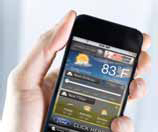Social Media, Mobile Apps Revolutionizing TV Weather

Weather Central’s Fusion Studio is built upon an HTML5-compatible tool kit that can serve all platforms, including mobile.
OTTAWA: Interactive weather software that connects directly to social media and lets broadcasters interact with viewers live; On-air monitors that give weather presenters an iPad-style interface; and downloadable apps from providers that—with a tweak—can be set to reflect branding for local broadcast clients: These are some of the features that can be found in today’s weather graphics on products for TV broadcast.
CONSUMER TRENDS
The burgeoning popularity of Facebook and Twitter—and their importance to TV audiences—is front-of-mind for TV weather graphics providers such as Accu- Weather, Baron Services, WSI and Weather Central, LP Small wonder: Their TV station clients are focused on integrating social media and its two-way capabilities with conventional broadcasting
“Every station that we talked with at NAB 2012 was asking about social media solutions,” said Bill Dow; vice president/ general manager of WSI’s Media Division. “This is because broadcasters understand that audiences are looking at them not just on-air, but on social media channels as well.”
In response, TV weather graphics providers are updating their systems to forge relationships via social media. MAX Social, WSI’s offering in this area, brings in usergenerated content for use on-air, while sending out breaking news and weather alerts to social media users.
However, social media isn’t the only force affecting weather graphics. The aesthetics of consumer technology, the ways in which viewers physically use their smartphones and tablet PCs, are also influencing how weather is being presented on TV.
Case in point: The interactivity of social media, combined with the drag, drop and expand capabilities of tablet PCs, has shaped AccuWeather’s StoryTeller application. Using a large on-air display in studio (no chromakey here), forecasters can now access graphics, maps and other visuals using the same kind of touchscreen motions used by viewers on their tablets. The result is a fast-moving, very flexible presentation style not just for weather, but indeed any form of on-air content.
Baron Weather App for iPhone “We liken the StoryTeller approach to a ‘big iPad on air,’” explained Dr. Lee Rainey, AccuWeather’s vice president of marketing. Compared to old-fashioned TV weather graphics, StoryTeller’s on-air interactivity is akin to “the difference between a professor lecturing, and students talking in the coffee shop,” he said.
Apps for iPhones and other smartphone platforms are incredibly popular with consumers. Mindful of this, weather graphics providers have created downloadable apps to keep viewers informed at all times, something today’s connected consumer demands.
“Smartphones and tablets have changed the whole weather equation,” said Ardell Hill; president of Broadcast Operations for Baron Systems. His company’s current offerings include the Baron Weather App for iPhone; Baron WeatherShare (for social media such as Facebook and Twitter); and Baron Omni3 (3D graphics). “Today, when viewers see clouds and hear a little rumbling, they go to their smartphones to see radar and find out what’s going in.” Broadcasters who do not support this capability on a real-time basis—on whatever platform users prefer—will be left behind.

Many of these apps can be tweaked to carry the branding and news supplied by a given provider’s closest TV affiliate. So although the app was made by Accu- Weather, it can carry the identity of the local AccuWeather TV station.
HIGH-QUALITY GRAPHICS
Although social media trends are having an impact on TV weather presentation, so too is the drive for ever-higher quality graphics—including 3D images that can work in both the 2D and 3D universes—and the integration of predictive graphics with actual local landmarks to let viewers experience tomorrow’s weather now.
This trend is being driven by the public’s love of video games, and how this love has affected their expectations. The result: Viewers have come to expect hyper-realism not only in the games they play, but the content they see online, and on their HDTVs as well.
At the same time, ease of operation is a must for busy TV meteorologists. This is why TV weather graphics providers are allowing users to input data into one location, with the software, then using it to populate many platforms.
For example, Weather Central’s Fusion Studio combines 3D graphics, social media connectivity, and easy-to-populate presentation interfaces into a single product. All of this is built upon a HTML5 compatible tool kit that can serve all platforms, including mobile. “Using our tool kit, stations can create what they need from scratch,” said Bill Boss, Weather Central’s vice president for Media Solutions. But they can do this quickly, allowing staff to literally do more with less.
As for the future? Whatever the “Next Big Thing” may be, its visual and interactive style will be reflected in TV weather graphics products. One thing is certain: The days of 2D weather maps dominated by squiggles and the letters “H” and “L” are numbered, if not over.
The professional video industry's #1 source for news, trends and product and tech information. Sign up below.
James Careless is an award-winning journalist who has written for TV Technology since the 1990s. He has covered HDTV from the days of the six competing HDTV formats that led to the 1993 Grand Alliance, and onwards through ATSC 3.0 and OTT. He also writes for Radio World, along with other publications in aerospace, defense, public safety, streaming media, plus the amusement park industry for something different.

